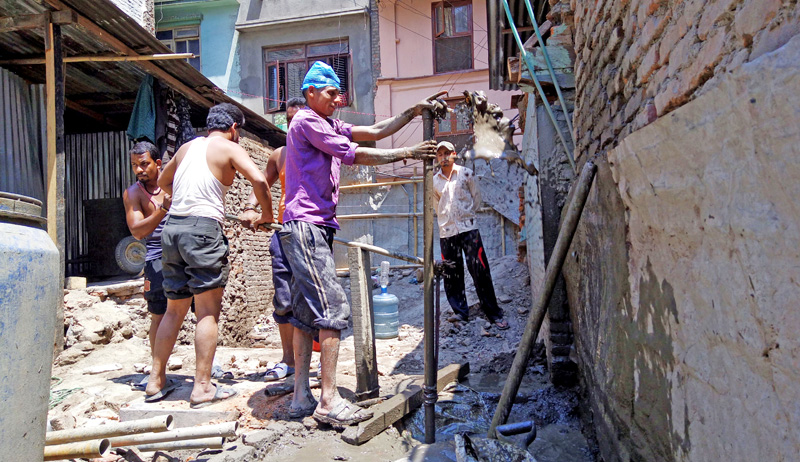‘Recharge Kathmandu programme unlikely to bear fruit’
Around 114 million litres of groundwater is extracted through deep borewells
Kathmandu, February 22
Kathmandu Metropolitan City recently inaugurated the much-hyped ‘Recharge Kathmandu’ programme in a bid to recharge the valley’s water table, which is rapidly declining due to intensive extraction of groundwater through deep borewells.
The programme began last Tuesday with the inauguration of a project which is likely to recharge groundwater in around 500 metre square of open area on the premises of KMC’s Ward No 26 office, in Gongabu.
Activists and water experts, however, said the KMC’s initiative to recharge the shallow aquifer beneath the earth’s surface would hardly have any impact considering the rapid decrease in the level of groundwater. KMC is spending Rs 500,000 for the programme that will harvest 767,000 litres of rainwater and recharge the groundwater.
Groundwater recharge rate is way less than the amount of groundwater extracted every day in Kathmandu valley. Around 114 million litres of groundwater is extracted every day through deep borewells inside Kathmandu valley. The amount includes 80 million litres of water extracted by Kathmandu Upatyaka Khanepani Limited, an authorised body to provide drinking water inside Kathmandu valley. KUKL extracts 80 million litres of water per day from 80 borewells that run more than 200 metres deep into the earth surface. Rest of the water is extracted by more than 900 privately owned deep borewells the valley.
Kathmandu Valley Water Supply Management Board, a government body authorised to provide licence to drill deep borewells inside Kathmandu valley states that there are above 1,000 deep borewells, out of which only 725 have been registered with them.
KVWSMB requires that every individual who digs a deep borewell must manage groundwater recharge system on their own, but very few people abide by the rule. Sanjeev Rana, executive director of KVWSMB, said so far only 125 registered deep borewells have water recharge system.
Prakash Amatya, chairman of GUTHI, an organisation that works to promote rain water harvest, said the government should focus on effectively implementing the rule to manage groundwater recharge system. He also said government should introduce incentives for industries and offices to encourage them to harvest rain water or install groundwater recharge system. Amatya said Rani Pokhari before the 2015 earthquakes was the best example for harvesting rainwater and recharging groundwater. He said Rani Pokhari, in the heart of the city, used to be refilled by the rainwater collected in nearby Durbar High School and Tri-Chandra college until a few years ago. Amatya said, “KMC could have introduced such programmes rather than installing water recharge systems, which is the responsibility of those who dig deep borewells.” He also criticised KMC for not enforcing existing laws that could have been instrumental in recharging groundwater in the valley.
Every year during rainy season, cities in Kathmandu valley get inundated due to rain water. Water experts say that one of the reasons for inundation is increasing concretisation. Environmentalist Bhusan Tuladhar said, “Our city is turning into a shield which obstructs rainwater from entering deep into the earth. This has destroyed natural drainage and all rainwater directly gets into the river system, which ultimately result into floods.”
Tuladhar suggested that the government should bring new rules with incentives to install rainwater recharge systems in private houses and organisations. A report made public by Japan International Cooperation Agency in 1990 stated that there could be a major natural imbalance if the extraction rate of groundwater exceeded 150 million litred per day inside Kathmandu valley






